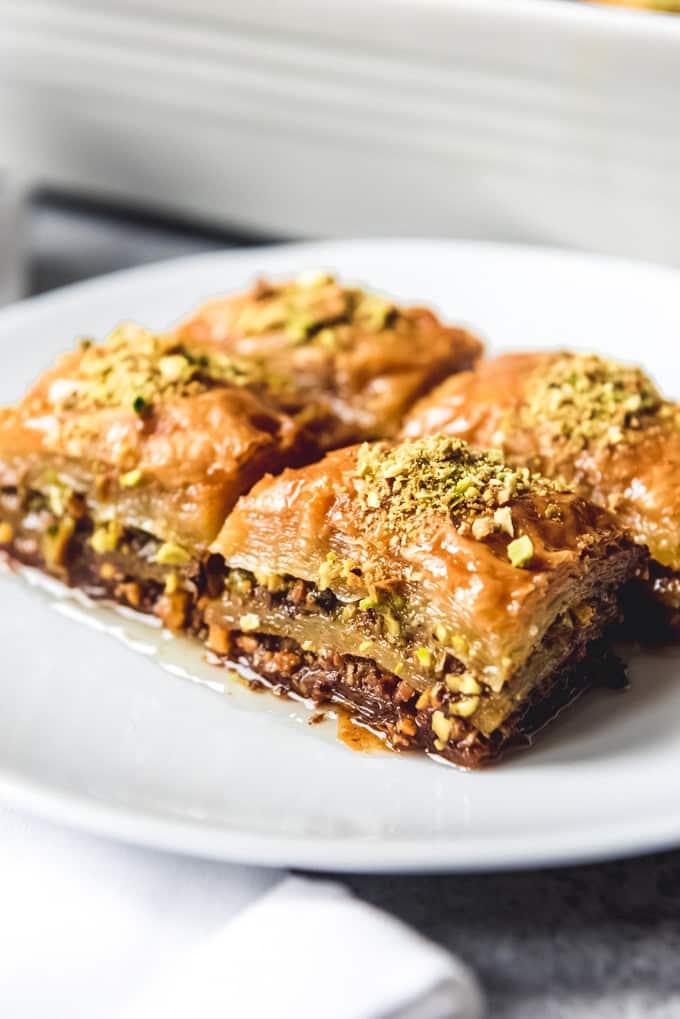In the past two blogs, we explored the compositions, histories, and origins of two different savory Mediterranean dishes. Today we will be exploring the traditional and famous Mediterranean dessert, baklava. Baklava consists of shredded wheat or layered phyllo dough, chopped nuts, and honey or syrup. It is served at room temperature as to keep it fresh and delicious, and can be eaten at any time of day, before and after meals.
Despite its fame, the history of baklava is not very well documented. Several countries of the Mediterranean, including Greece, Turkey, and several Middle Eastern countries claim baklava as their own creation, creating many different accounts of the history of the dish. According to the Greek Reporter, one account claims that the Assyrians had been preparing baklava since the 8th century and that the Greeks and other countries discovered baklava through seafaring and trading. Others say that baklava had originated from the Byzantine era. Professor Speros Vryonis defends this theory by relating the similar Greek dish, kopton, to baklava. However Charles Perry, an American journalist, argues against that theory, claiming baklava is a Turkish-Central Asian dish.
No matter their histories, these three dishes will remain as some of the most traditional and famous dishes of the Mediterranean.
Bibliography:
Kokkinidis, Tasos, The Greek Reporter, Baklava: The Dessert that has Greeks an Turks Fighting over Origins, https://greece.greekreporter.com/2017/12/17/baklava-the-dessert-that-has-greeks-and-turks-fighting-over-origins/ Dec 17, 2017
"Habeeb," Habeeb.com, What is Baklava? The History of Baklava, http://www.habeeb.com/about.baklava.html
Yalava-Heckeroth, Feride, Culture Trip, The History of Baklava in 1 Minute, https://theculturetrip.com/europe/turkey/articles/the-history-of-baklava-in-1-minute/
Despite its fame, the history of baklava is not very well documented. Several countries of the Mediterranean, including Greece, Turkey, and several Middle Eastern countries claim baklava as their own creation, creating many different accounts of the history of the dish. According to the Greek Reporter, one account claims that the Assyrians had been preparing baklava since the 8th century and that the Greeks and other countries discovered baklava through seafaring and trading. Others say that baklava had originated from the Byzantine era. Professor Speros Vryonis defends this theory by relating the similar Greek dish, kopton, to baklava. However Charles Perry, an American journalist, argues against that theory, claiming baklava is a Turkish-Central Asian dish.
Bibliography:
Kokkinidis, Tasos, The Greek Reporter, Baklava: The Dessert that has Greeks an Turks Fighting over Origins, https://greece.greekreporter.com/2017/12/17/baklava-the-dessert-that-has-greeks-and-turks-fighting-over-origins/ Dec 17, 2017
"Habeeb," Habeeb.com, What is Baklava? The History of Baklava, http://www.habeeb.com/about.baklava.html
Yalava-Heckeroth, Feride, Culture Trip, The History of Baklava in 1 Minute, https://theculturetrip.com/europe/turkey/articles/the-history-of-baklava-in-1-minute/


Comments
Post a Comment